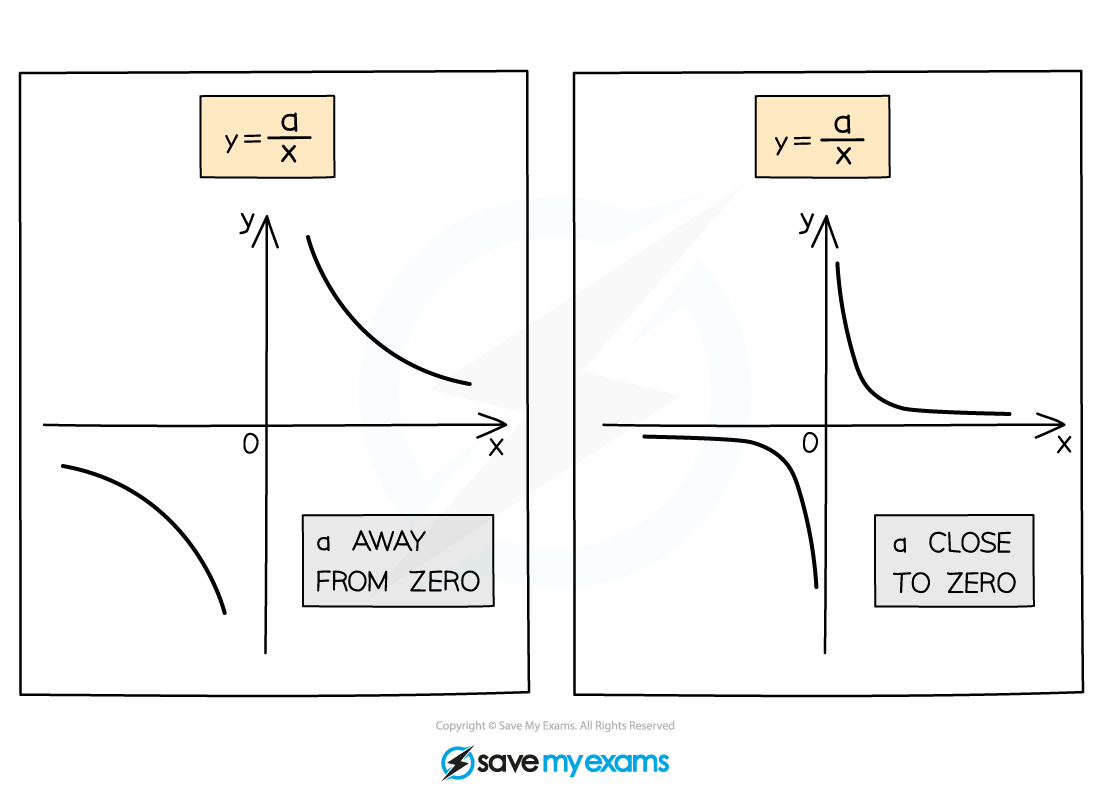Types of Graphs
What graphs do I need to know?
- You need to be able to recognise the following lines:
- Straight lines
- y = mx + c
- Such as y = 3x + 2, y = 5x - 1, ...
- Two important ones are y = x and y = -x
- Horizontal lines
- y = c
- Such as y = 4, y = -10, ...
- Vertical lines
- x = k
- Such as x = 2, x = -1, ...
- Straight lines
- You need to be able to recognise quadratic graphs
- y = x2
- y = -x2
- y = ax2 + bx + c
- You also need to be able to recognise reciprocal graphs
What does a quadratic graph look like?
- The equation of a quadratic graph is y = ax2 + bx + c
- A quadratic graph has either a u-shape or an n-shape
- This type of shape is called a parabola
- u-shapes are called positive quadratics
- because the number in front of x2 is positive
- For example, y = 2x2 + 3x + 4
- because the number in front of x2 is positive
- n-shapes are called negative quadratics
- because the number in front of x2 is negative
- For example, y = -3x2 + 2x + 4
- because the number in front of x2 is negative
- You can plot quadratic graphs using a table of values

What are the key features of a quadratic graph?
- The point where the graph turns is called the vertex
- Positive quadratics have a minimum point
- The bottom of the u-shape
- Negative quadratics have a maximum point
- The top of the n-shape
- Positive quadratics have a minimum point
- Quadratic graphs always have a vertical line of symmetry down the middle
- The equation of the vertical line of symmetry is x = k
- k is the x-coordinate of the minimum or maximum point
- The equation of the vertical line of symmetry is x = k
- Quadratic graphs do not have to cross the x-axis
- If they do, two x-intercepts are created, called roots
- If the curve just touches the x-axis, only 1 root is created
- Roots are symmetric about the vertical line of symmetry
- If they do, two x-intercepts are created, called roots
- Quadratic graphs always have one y-intercept
What does a reciprocal graph look like?
- The equation of a reciprocal graph is
- You cannot substitute in x = 0 (division by zero is not allowed)
- You should not include x = 0 in a table of values
- You cannot substitute in x = 0 (division by zero is not allowed)
- The shape of
is shown below (for a positive value of a)
- It has two two curved branches
- The branches are L-shaped
- The L is more rectangular when a is smaller
- The branches never connect!
- It has two two curved branches
- A negative value of a reflects the shape in the y-axis

Worked example
In each of the cases below, state the letter of the graph that corresponds to the equation given.
|
A
|
B
|
C
|
D
|
E
|
(a)
This is a straight-line graph, y = mx + c
Graph D
(b)
This is a quadratic graph, y = ax2 + bx + c (a = -1, b = 3, c = 2)
The number in front of x2 is negative so it has an n-shape
Graph C
(c)
This is a reciprocal graph, format('truetype')%3Bfont-weight%3Anormal%3Bfont-style%3Anormal%3B%7D%3C%2Fstyle%3E%3C%2Fdefs%3E%3Ctext%20fill%3D%22%230F7DAB%22%20font-family%3D%22Times%20New%20Roman%22%20font-size%3D%2218%22%20font-style%3D%22italic%22%20text-anchor%3D%22middle%22%20x%3D%224.5%22%20y%3D%2230%22%3Ey%3C%2Ftext%3E%3Ctext%20fill%3D%22%230F7DAB%22%20font-family%3D%22math17f39f8317fbdb1988ef4c628eb%22%20font-size%3D%2216%22%20text-anchor%3D%22middle%22%20x%3D%2218.5%22%20y%3D%2230%22%3E%3D%3C%2Ftext%3E%3Cline%20stroke%3D%22%230F7DAB%22%20stroke-linecap%3D%22square%22%20stroke-width%3D%221%22%20x1%3D%2229.5%22%20x2%3D%2242.5%22%20y1%3D%2223.5%22%20y2%3D%2223.5%22%2F%3E%3Ctext%20fill%3D%22%230F7DAB%22%20font-family%3D%22Times%20New%20Roman%22%20font-size%3D%2218%22%20font-style%3D%22italic%22%20text-anchor%3D%22middle%22%20x%3D%2236.5%22%20y%3D%2216%22%3Ea%3C%2Ftext%3E%3Ctext%20fill%3D%22%230F7DAB%22%20font-family%3D%22Times%20New%20Roman%22%20font-size%3D%2218%22%20font-style%3D%22italic%22%20text-anchor%3D%22middle%22%20x%3D%2235.5%22%20y%3D%2241%22%3Ex%3C%2Ftext%3E%3C%2Fsvg%3E)
It has two L-shaped branches
It has two L-shaped branches
Graph B






